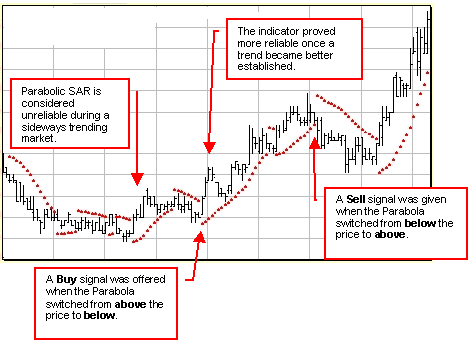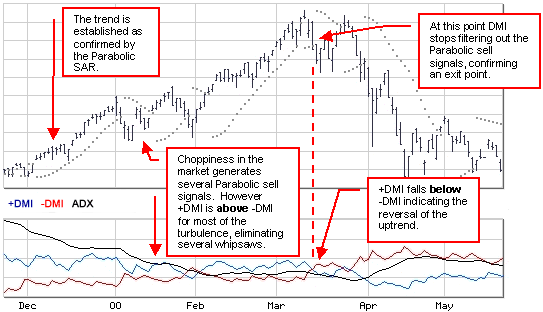

The Parabolic System, developed by Welles Wilder who also developed the Relative Strength Index (RSI), is usually referred to as the Parabolic "SAR" (stop-and-reverse). Mr Wilder designed this indicator to supplement the other trend-following systems.
The Parabolic SAR is a "stop-loss" system used to set trailing price stops. The name of the system is derived from its parabolic shape, which follows the price movements in the form of a dotted line. When the parabola follows along below the price, the trader should be buying or going long. A parabola above the price suggests selling or going short.
The particular value of the Parabolic SAR is that it allows traders to catch new trends relatively early. If the new trend fails, the parabola quickly switches from one side of the price to the other, thus generating the stop and reverse signal.
Mr. Wilder built an acceleration factor into the Parabolic system. To allow the trend time to become established, the movement of the indicator starts off slowly - with the dots close together. As acceleration increases, the parabola move faster (with the dots further apart) until it catches up to the price action.
As with most indicators, Parabolic SAR performs best in trending markets, and is less reliable during sideways or congestive phases.
The Parabolic SAR is an outstanding indicator for providing exit points - offering sell signals when the parabola moves above the price. Buy signals are generated when the parabola falls below the price. Of course, these signals need to be confirmed by the price action itself and other, complementary indicators.
It is always useful to examine different time periods; using daily, weekly and monthly charts.
John Murphy, author of Technical Analysis of the Financial Markets, recommends using a filter to complement the Parabolic system. He suggests using the Directional Movement Index (DMI) to help eliminate whipsaws and false signals in the more sensitive Parabolic system. As a simple rule of thumb, he observes that the DMI and Parabolic SAR indicators can complement one another as follows: "When the +DI line is above the -DI line, all Parabolic sell signals can be ignored." We can see the effectiveness of this strategy below. (The ADX line is essentially the smoothed difference between the +DI and -DI lines.)

Refer to Welles Wilder's book New Concepts in Technical Trading Systems for a thorough discussion of Parabolic SAR.
Also refer to the Directional Movement Index (DMI) indicator.